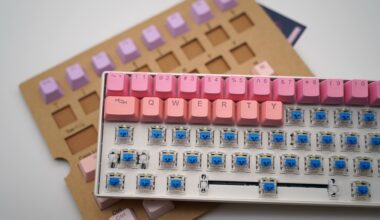Working towards bright, successful future demands suitable accessories that’d assist you in your daily work.
Minor details such as having a quality work desk, good ventilation in your office or home office, having adequate desk light are some of the keys to robust productivity.
Good office lights, primarily desk lights, are an essential component that would help you during late working hours and dusky days.
Additionally, a good desk light can accompany you during your overtime work or during a deadline day, so choosing the best desk light possible is as important as any other office accessory.
In general, a desk with lights with 450 lumens (6 watts) LED light is sufficient for several common tasks like writing and reading for home offices. However, the recommended brightness level is 800 to 1000 lumens (12 to 14 Watts) in LED lights for more delicate tasks. Similarly, higher kelvin(K) values, such as 4000K and above, are more effective for desk lighting.
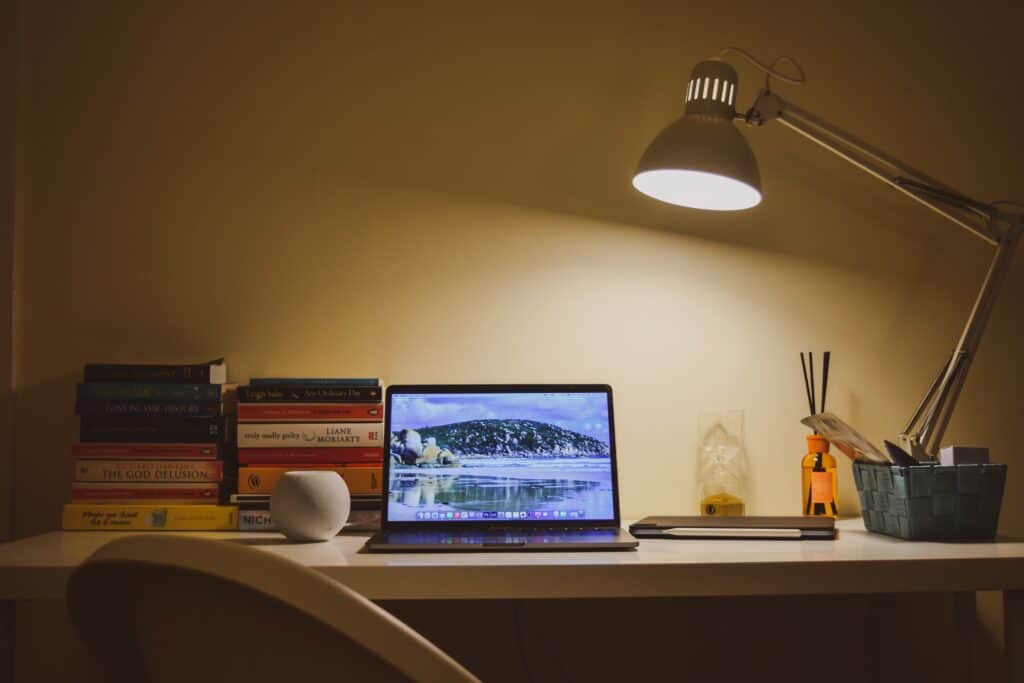
It would be best to keep certain things in mind while choosing a desk light for your home office.
When it comes to buying the perfect light for your desk, it’s vital to understand the ins and outs of modern desk lamps so you can pick the perfect one for you.
Table of Contents Show
Practical Things to Consider While Buying Desk Light for Home Office
It can be hard to find the right desk lamp for your workspace, especially if you consider all of the factors to look for when choosing your desk lamp.
When it comes to choosing the perfect desk lamp, we all have various requirements.
Basically, which desk light is best for you depends on the task you want to perform and your eyesight demands.
There are a variety of styles available, each with its own set of features.
This is fantastic because there is a suitable desk lamp for everyone with so many options on the market now.
Before choosing the perfect desk lamp for your home office desk, you need to ask some questions too.
1. Purpose of your Desk Lamp
The basic function of a desk lamp is, of course, to provide light.
However, the desk lamp holds a considerably more functional role. Task lighting is a common term for desk lamp lighting.
The correct work lighting can improve your mood and reduce eye strain, and you’ll be able to increase your productivity.
You want to be able to see comfortably and clearly, whether you’re hammering away on the computer or reading the fine print. This is where a desk lamp can help.
2. Position and Direction of your Desk Lamp
As mentioned earlier, the basic function of a desk lamp is to provide light to your work area that lowers eye strain.
The positioning of your lamp is also important in ensuring that you get the most out of your desk lamp.
Depending on your demands, a general rule is to set your light 15 to 36 inches away from your work area.
Many desk lamps now have adjustable arms so you can get the perfect height.
I noticed during my research that you should think about which side of your lamp to put it on.
You should always place the desk lamp on your left side if you are a right-handed person, and vice versa if you are a left-handed person.
In addition, your desk light should be placed higher than your head but out of your eyes; it should never be in direct line of sight with your eyes.

It may not give adequate coverage for your work area if it is set too low; if it is too high, the light may become highly diffused.
A desk lamp with the flexibility to be angled and adjusted will provide you with the versatility you require to comfortably angle and place the light.
You can also brighten up your workstation with additional lightings, such as wall or clip lights.
Tip: Placing a task lamp or other light source behind your computer screen can assist reduce eye strain by offsetting the screen’s brightness.
3. The Right Amount of Light for your Workspace
Your workplace should get the right amount of light. But, on the other hand, you don’t want your workspace to be too dull or too bright.
Eye strain is a major concern these days, with so many people spending so much of their time at computers staring at computer screens.
Find a lamp with a more directional beam. For task lighting, an LED light is ideal. LEDs not only use less energy and last longer, but they also offer a direct beam.
According EN 12464 Light and lighting, the recommended light for your workspace should be 500 lux (lumen/m2).
An LED bulb with at least 600 lumens should be used to achieve 300 lux workplace illumination. For example, with a 1,000-lumen desk light, you will achieve 500 lux for your workspace.
LED bulbs are optimal for task illumination, and most desk work, you’ll need one that’s at least 5-10 watts.
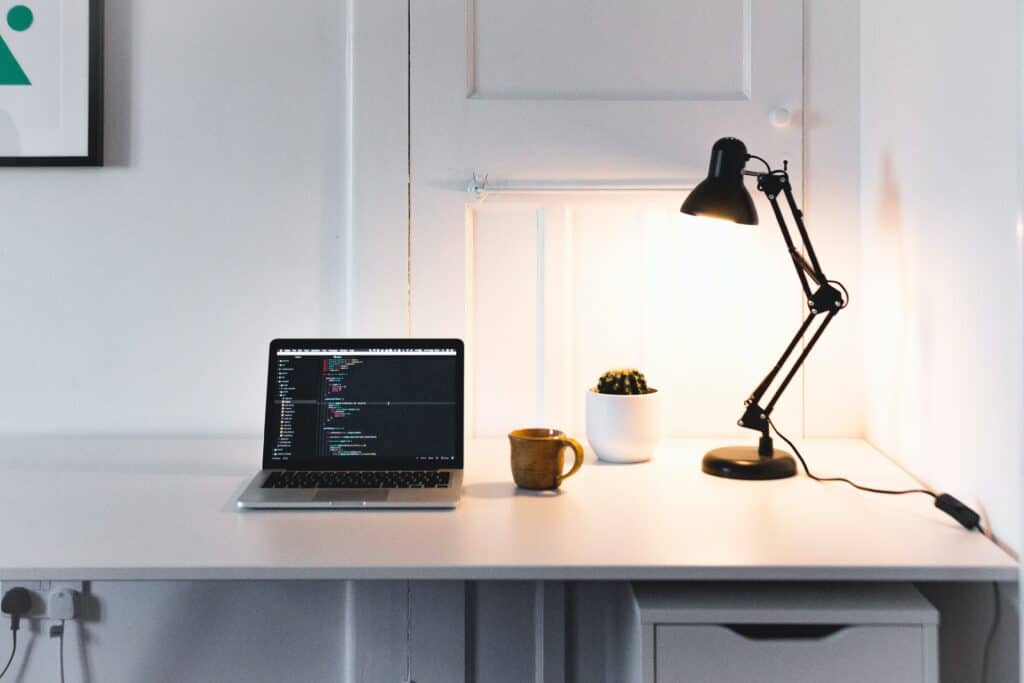
4. How Much Light do you Need? Is Age a Thing to Consider?
The human visual system deteriorates throughout the very normal adulthood. Therefore, until approximately 40 years of age, the visual system is typically referred to as “young.”
As visual abilities deteriorate, typical changes to the aging eye become more evident.
For example, as you get older, the more light you need, a person over 50 requires twice the amount of light as a 25-year-old.
At the same time, because older eyes are more susceptible to glare, getting a good desk lamp with a regulated beam of light is more crucial than ever (instead of a regular table lamp that puts out light in all directions).
According to the scientific research, the amount of light in older people’s living spaces should be raised by at least 50% over what is comfortable for younger people. Ambient light levels should be at least 300 lux in general (lx).
Similarly, the lighting level for the task should be at least 1000 Lumens in general.
Although the aging eye requires more light to see clearly, consideration must be given to avoid glare.
How Much Light Do You Need? Now, you can calculate amount of light according to your need using Lumen Calculator.
I have created a table for light recommendations according to your age. This is based on scientific research.
| Age | Incandescent | Halogen | CFL | LED |
|---|---|---|---|---|
| 5 to 12 Years | ≤40 Watts | ≤ 20 Watts | ≤5 Watts | 3 to 5 Watts |
| 12 to 24 Years | ≥ 60 Watts | ≥ 50 Watts | ≤9 Watts | ≤ 5 Watts |
| 25 to 46 Years | ≥ 60 Watts | ≥ 50 Watts | ≤15 Watts | 5 to 10 Watts |
| 46 to 75 Years | ≥ 100 Watts | ≥ 50 Watts | ≤15 Watts | 5 to 10 Watts |
9 Things to Consider Before Choosing the Perfect Desk Lamp
Desk lamps are available in a variety of shapes and finishes. Because taste is subjective, there is no right or wrong answer in this department—the style, size, shape, and finish are all up to you.
However, selecting a lamp type that complements your workspace’s décor is a good idea. Here are some things that you need to consider before choosing the desk light for your home office.
1. Consider Desk Lamp Size
Consider the size of your desk and the type of work you do there when planning your workplace.
There is no exact rule to follow here, but there is a general guideline to keep in mind.
A desk light should be proportionate to your desk or workspace; for example, if you have a large desk, you’ll need a larger lamp.
On the other hand, a small lamp would be acceptable if you have a small desk.
Taller desk lamps with a long arm that can extend across the length of your desk are ideal for larger desks, such as drawing tables, where a wider area needs to be illuminated.
Sometimes, rearranging your desk is the best solution so that your lamp can fully illuminate your workspace.
When selecting a desk light, keep the size of your workdesk in mind. Read more: What is the Right Size Desk for your Home Office?
2. Consider Desk Lamp Type
Another crucial factor to consider is the type of desk lamp you want to get for your home office. Again, there is a wide variety of desk lamps available in the market.
Some types are mentioned below:
a. Adjustable Arms Lamps
Adjustable lamps allow you to move the light source closer or farther away, depending on your demands and workspace. Larger desks will benefit from it.
b. Magnifying Lamps
Magnifying lamps are highly adjustable, excellent for table use. You can easily place the magnifying lens for quick and varied changes.
There’s no need to reposition it all the time. The Clamp Lamps on/off switch is situated at the bottom of the head, right under the lens,, for quick and simple access.
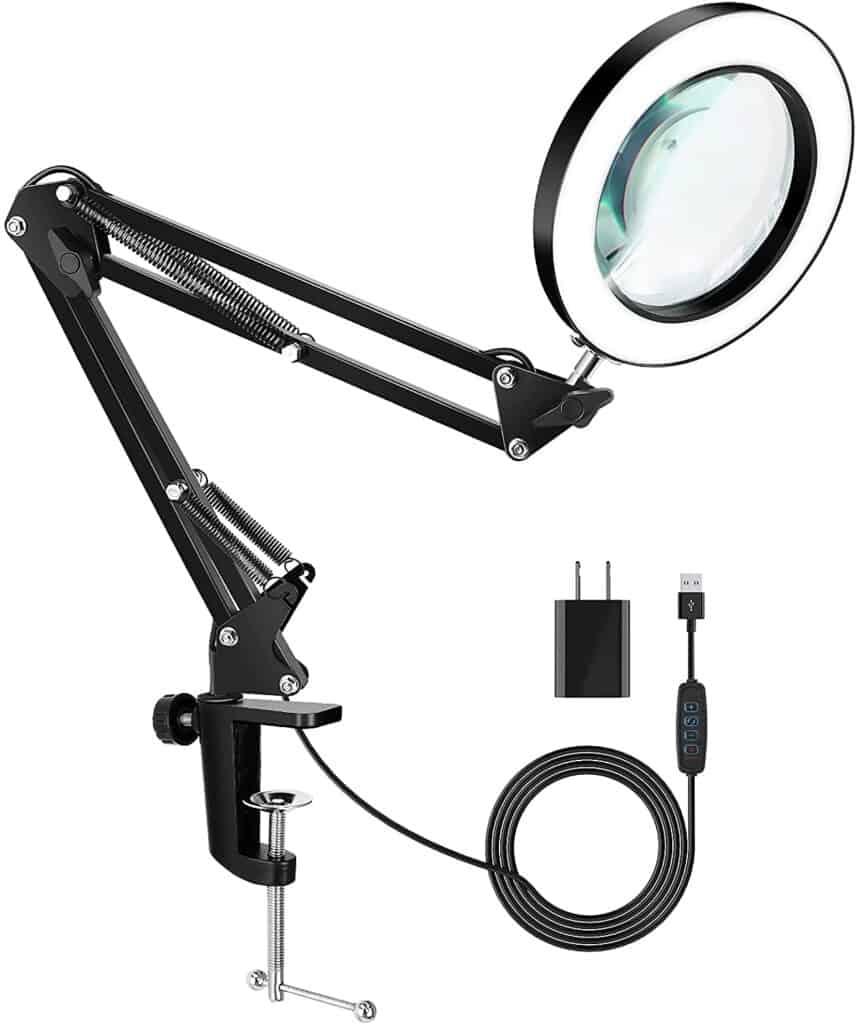
Check the latest price on Amazon: Magnifying Lamp
c. Bankers Lamps
Bankers’ desk lamps offer a classic design and vintage feel to your home office.
The Banker’s Desk Lamp is a perfect directional light source for reading, accounting, or crafting, and it comes with an LED bulb.
Because of its strong construction, you may use its gold-colored On/Off-chain with confidence.
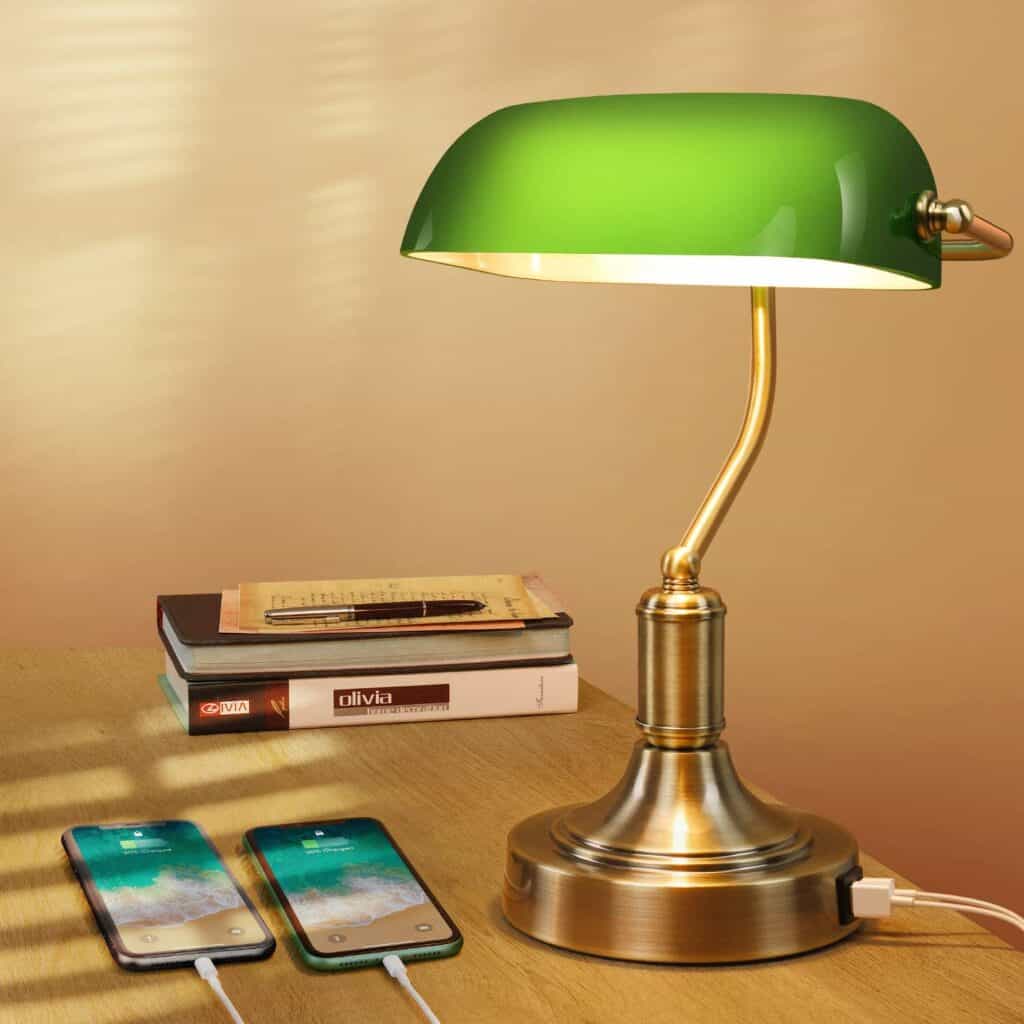
Get this beautiful Banker’s Lamp on Amazon.
LED lighting saves you money by using less energy than typical incandescent lamps. They also emit less heat, making them better suited to small home offices.
d. Clip-on Lamps
Eye-Caring LED Light (clip-on or free-standing) lamp Clamps securely to a desk, table, or bed headboard.
Clip-on lamps have gooseneck flexibility, allowing you to light up exactly where you need them.
It may also be folded into a little lamp when not in use to save room when traveling.
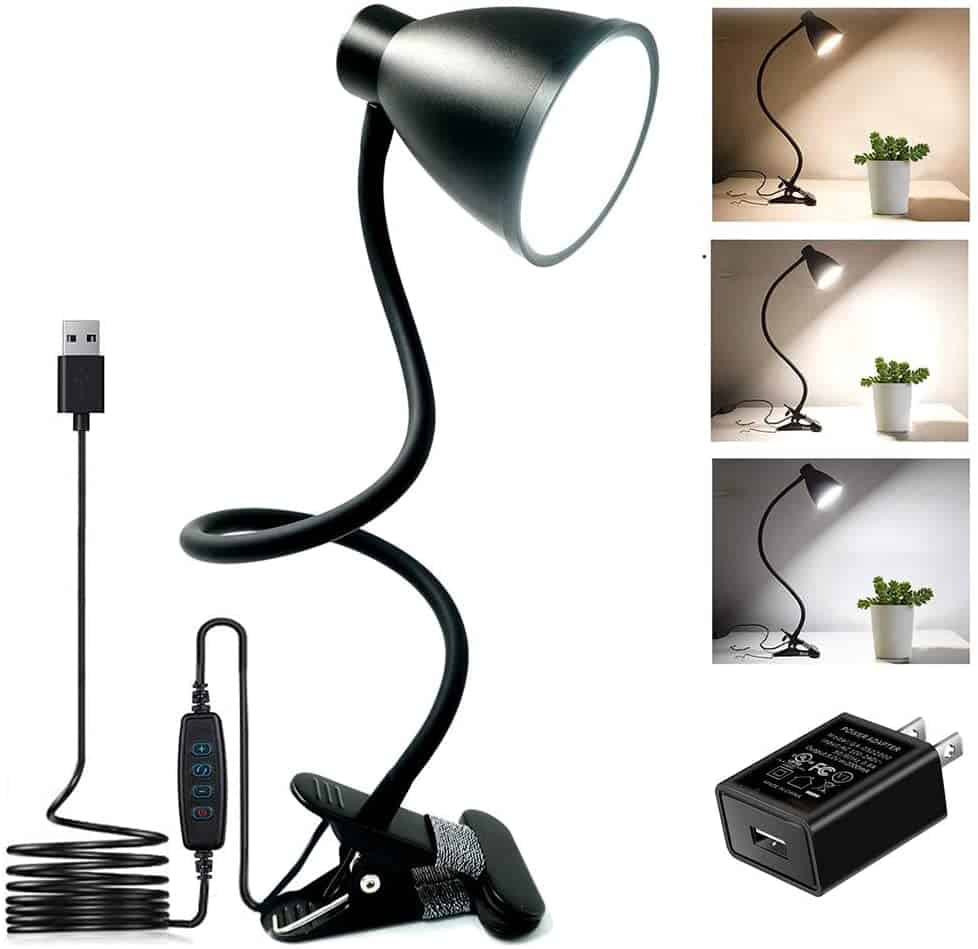
Check the latest price on Amazon: Clip-on Desk Lamp
e. Goosenecks Lamps
Gooseneck lamps are designed with a sturdy metal clamp that can be easily attached to the light and placed on your desk or anywhere else with an edge surface.
They are ideal for your home office desk.
Why work inside with artificial lighting? Why not go outside, Learn more if Direct Sunlight is damaging your device.
3. Consider Type of Lighting for your Workdesk
Desk lamps come with various light sources, each with its own set of advantages and disadvantages.
The correct light bulb can assist you in illuminating and focusing on your task without causing strain to your eyes.
Some of the lighting types are:
a. Fluorescent Light
Fluorescent light creates light through the fluorescence of a phosphor coating and is cooler and more efficient than incandescent lights.
You can find Fluorescent lamps almost everywhere due to their widespread availability.
As a fluorescent light gets older and becomes less efficient, it requires more and more voltage to generate the same light.
Fluorescent lights are not good for your home office as their flickering effect damages your eyes and might also cause migraines.
If you are still using fluorescent lights for your desk lamp, replace them immediately with more efficient lights.
b. Incandescent Light
The incandescent light bulb is the most common type of light bulb. It generates light by heating a wire filament to a temperature that causes light to be generated.
A translucent glass bulb surrounds the metal wire, either filled with an inert gas or evacuated (a vacuum).
The energy efficiency of incandescent lights is the lowest on the market. The efficiency of incandescent bulbs is roughly 10 lumens per watt.
Unfortunately, most of the energy incandescent light use (90 percent) is used to generate heat.
These lightings are not ideal for your home office as it has a short lifespan.
In addition, incandescent lights are not ideal for task lighting. Therefore, it is better to avoid incandescent lights.
c. Light-Emitting Diodes Light
LEDs (Light Emitting Diodes) are the most recent lighting innovation. LED lights are used for various applications, including night illumination, art lighting, and outdoor lighting.
Due to their efficiency, color spectrum, and extended lifespan, these lights are ideal for your home office.
And Thanks to the innovation, they consume less energy. The best lighting type to consider for a home office is LED.
d. Halogen Light
The halogen light bulb, often known as a halogen lamp, is an incandescent lamp that uses halogen gas to boost light output and rated life.
Compared to normal incandescent lights, they are noted for their moderately high efficiency, light quality, and rated life.
Halogen lights are not that great for home office use, as they consume more energy and the bulb gets much hotter. In addition, they don’t last longer than LEDs.
e. Compact Fluorescent Light
A compact fluorescent lamp (CFL) is a fluorescent lamp designed to replace an incandescent light bulb.
It is also known as a compact fluorescent light, energy-saving light, or compact fluorescent tube.
They are more energy-efficient than incandescent bulbs but not as efficient as LED bulbs.
If working indoors what should be your appropriate Screen Brightness.
4. Consider Luminosity and Brightness
The primary function of lights, such as desk lamps, is to brightness the whole desk.
So, it would be evident that you would want a light or a lamp with the best luminosity while choosing a desk light for your home office.
It is recommended to get the light having 450 lumens (6 watts) LED light is sufficient for several common tasks like writing and reading. However, the recommended brightness level is 800 to 1000 lumens (12 to 14 Watts) in LED lights for more delicate tasks.
Good brightness in the morning enables the user to prefer their usage over other random lights.
To determine the quality of the light in terms of brightness, you can observe these points and examine them yourself.
- The light bulb should not flicker after constant use. Working under a gloomy light can be burdensome and can drag your focus away from your work.
- On the other hand, the light should also not be too bright. Working under bright lights for an extended time might end up damaging your eyes.
- Light bulbs made for strain relief on the eyes should be preferred.
- Light bulbs emanate heat along with light.
- Choosing a light that provides the best light conversion should be highly suggested as you would not want to get cooked up in your own home office during hot summer days.
So, having quality luminosity in the desk light in your home office is crucial for well-managed office space.
| Lumen (Brightness) | LED Watts | CFL (Watts) | Incandescent Watts |
|---|---|---|---|
| 400 to 500 Lumens | 6 to 7 Watts | 8 to 12 Watts | 40 Watts |
| 650 to 850 Lumens | 7 to 10 Watts | 13 to 18 Watts | 60 Watts |
| 1000 to 1400 Lumens | 12 to 13 Watts | 18 to 22 Watts | 75 Watts |
| 1450 to 1700 Lumens | 14 to 20 Watts | 23 to 30 Watts | 100 Watts |
| 2700 + Lumens | 25 to 28 Watts | 30 to 55 Watts | 150 Watts |
Though it is known to have good quality lights in your bulb, we hope the points mentioned above have successfully convinced you.
5. Consider Good Quality
Talking about light’s “quality,” we’re referring to how dispersed it is and what sorts of shadows it casts, not how effective or expensive it is.
Keeping track of the light quality in your office may help you fine-tune your area’s look.
Go for the good quality lights. Confused about buying good quality desk lamp? Don’t worry; I will guide you through it.
CRI and Color Temperature are two important factors to consider for the light’s quality.
Improve your Gaming Room aesthetics by adding lights and other changes.
a. Color Rendering Index
The Color Rendering Index (CRI) is a metric that quantifies how true-to-life colors seem under different lighting conditions.
This rating is particularly crucial for desk lamps, which require the capacity to discern contrast when reading and working. Choose LEDs with high CRI ratings of 85 to 100.
It has been proved that the greater the CRI, the lower the illuminance at a specific place. Therefore, for all general works, CRI having 80 is a good standard.
The CRI of halogen and incandescent bulbs is always 100, whereas the CRI of most high-quality LED lamps today is 80.
b. Color Temperature
Another factor to consider is the Color Temperature of Light. Color Temperature is a standard measure of a light’s appearance, referred to as a “warm” or “cool” appearance.
The color temperature comes in different ranges.
Warm White: This is the warm and soft white range ideal for relaxing or entertaining your space (For example, a light with a 3000k color temperature).
Natural White: This neutral white light range provides a good blend of warm and soft hue light (For example, a light with a 4000k color temperature).
Cold White: This daylight color temperature is appropriate for offices, workshops, and other spaces that require good detail visibility (for example, a light with a 5700k color temperature).
LED desk lamps in the 2700K to 4500K color temperature range often provide a clear and attractive light to work under.
For task lighting, higher kelvin(K) values, such as 4000K and above, are more effective and better for illuminating, resulting in reduced eye strain.
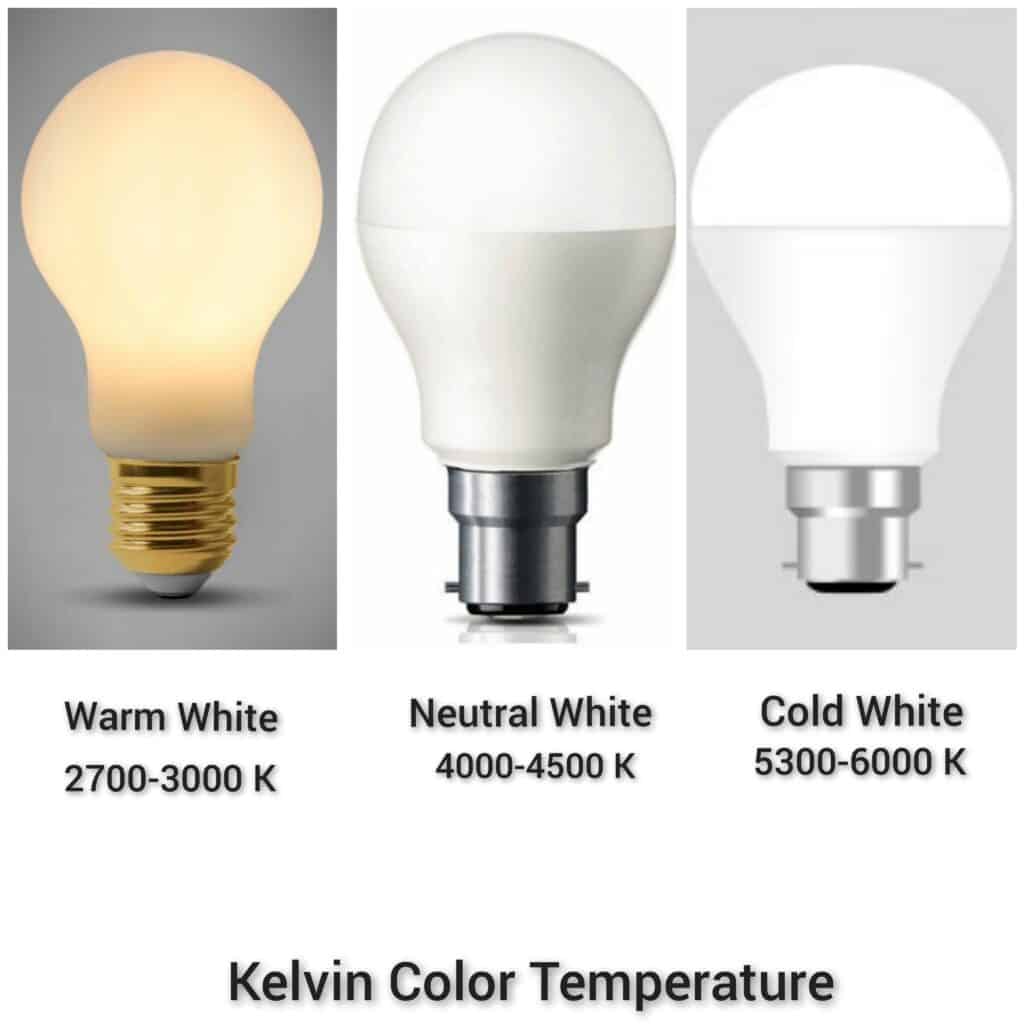
Cool color temperatures promote brain processes and may increase productivity.
Warm color temperatures are calming, whereas cooler color temperatures stimulate brain functions and may boost productivity.
As a result, knowing this will help you in choosing the optimal type for your workspace.
6. Consider How Much Energy is your Desk Light Consuming
Not every desk lamp uses the same amount of energy as the next. For example, the incandescent desk lamp is the least efficient, while the LED is the most efficient.
Do your homework on the energy output of the desk lamp you’re considering buying. Then, go for Desk lamps that are less energy-consuming and much more efficient.
7. Consider Durability
Having good quality lights is an essential factor, but their long-term durability is equally important. When you get settled into your home office, having to change lights from your desk would be a big bummer.
Having an old but sturdy and robust light adds character to your office, and any client might get impressed with your long-term management skills.
Furthermore, having durable desk lights are essential for the following reasons:
- Constant purchase and replacement of your desk light would be expensive and inconvenient.
- Rewiring and replacing a flimsy desk light would be burdensome and time-consuming. You would be wasting your precious time that you could’ve used for your work.
- Buying a durable desk light would provide a big bang for your buck.
When choosing a desk light for your home office, going for a durable product instead of a cheap one would be suggested.
Should you work with lights on or off? Is it Bad.
8. Consider Versatility
Like any other product, having a versatile desk light would always be preferred over regular single-function light.
Versatility in desk light refers to its ability to be used in extreme conditions and long workdays.
Having versatile desk lights are essential for the following reasons:
- First, during a project deadline or a long workday, you might want to work till late, primarily when you work in your own home office.
- After years of use, the light should be as proper as usability as when it was new.
- Having a long-lasting battery or energy-efficient circuit board would benefit the desk light user in reducing energy consumption.
- It should be usable during nighttime and dark or cloudy days.
Having a versatile work desk light option would surely be preferable while choosing one for your home office.
9. Consider Value and Affordability
When you start, you might not have the best resources and means. For example, during the initial phase of your home office, having an affordable work desk light would be a precious component of your office.
Additionally, if you pay a reasonable price for the desk light, you should choose one that provides the best value and performance.
Furthermore, investing the majority of your income in light would also not be acceptable.
So instead, you should choose a desk light that provides all the qualities mentioned above and is affordable on your budget.
Choosing an accessory for your office, even if it’s priced higher, would be worth it if it provides the value for the money it’s priced at.
Additionally if the desk light can be quickly or cheaply repaired despite its purchase price despite its purchase price, it would also add value to the product.
We hope you know what qualities to look for in a desk light for your home office.
Best Desk Light for Home Office
Though you know how to choose one of these lights, you might not know which office desk lights are some of the best ones out there.
So here are our top recommended desk lamps that you can choose from.
1. LED Desk Lamp Eppiebasic
With a very broad 23.6-inch LED light bar for full desk coverage, the Eppiebasic office table lamp is sleek and minimalist.
The desk lamp provides 80W incandescent bulb equivalent light covering the entire desk workspace evenly.
LEDs Eppiebasics are highly efficient that use 80% less energy, and lasting 50,000 hours.
This desk light is good for studio, monitor, drawing, sewing, crafting, painting, and reading since it softens the harsh brightness of the screen and illuminates everything on your desk.
This contemporary work light is the ideal way to brighten up your home office.
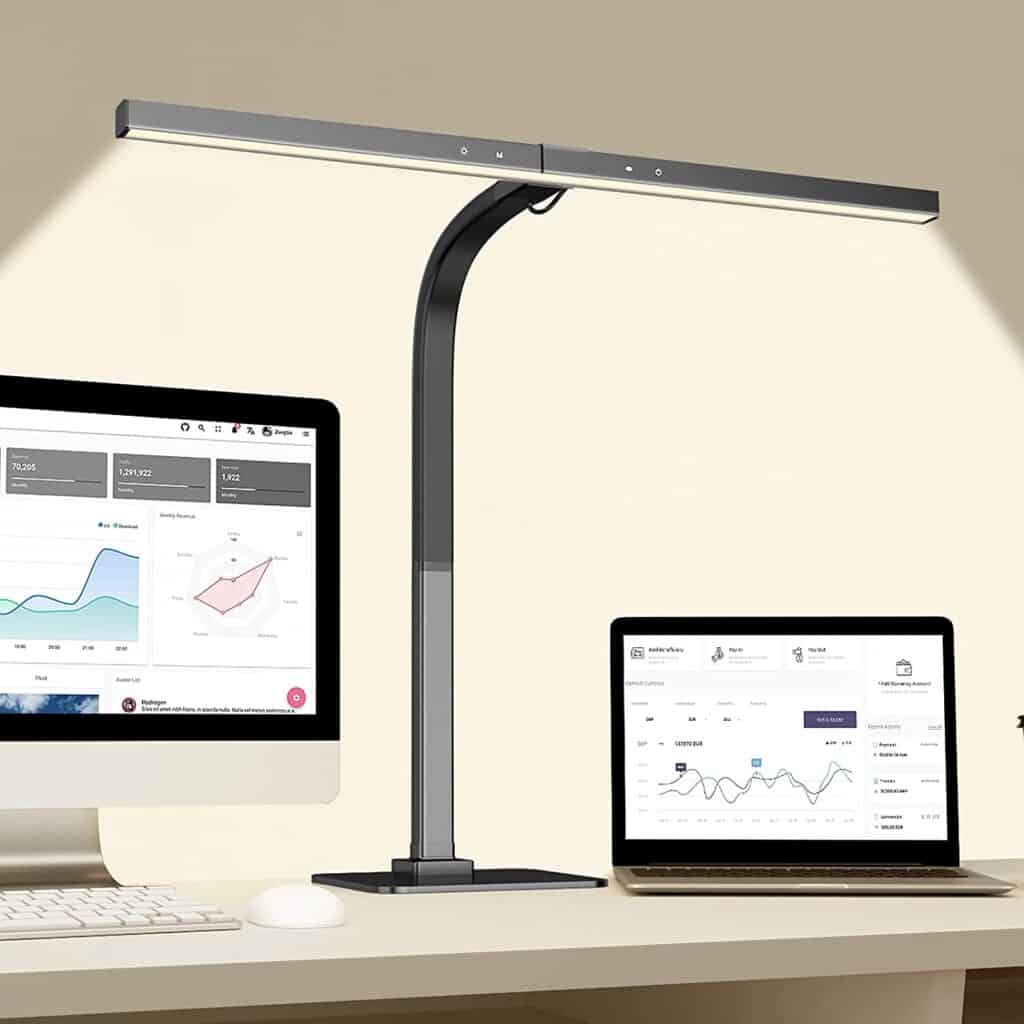
Check the latest price on Amazon: LED Desk Lamp Eppiebasic
Pros
- Highly Efficient
- Adjustable and Eye Caring
- The light sensor switch automatically adjusts the light intensity based on the environment.
- Comfortable light, Non- Flickering
Cons
- The power button appears unfinished with a metal piece that is uncentered and uneven.
- Along with the connections, the power supply is big and appears to be quite cheap.
- A lower height adjustment than 48 inches is not possible due to the neck.
2. Dott Arts Clamp Desk Lamp
Desk Lamp by Dott Artisone of the best value desk lights with adjustable color temperature and multiple brightness settings that provide various light sources from the same device.
These lamps are paired with a Smooth Illuminating diffuser that keeps eye strain at the surface so that you can continue working, reading, or studying with minimal exhaustion.
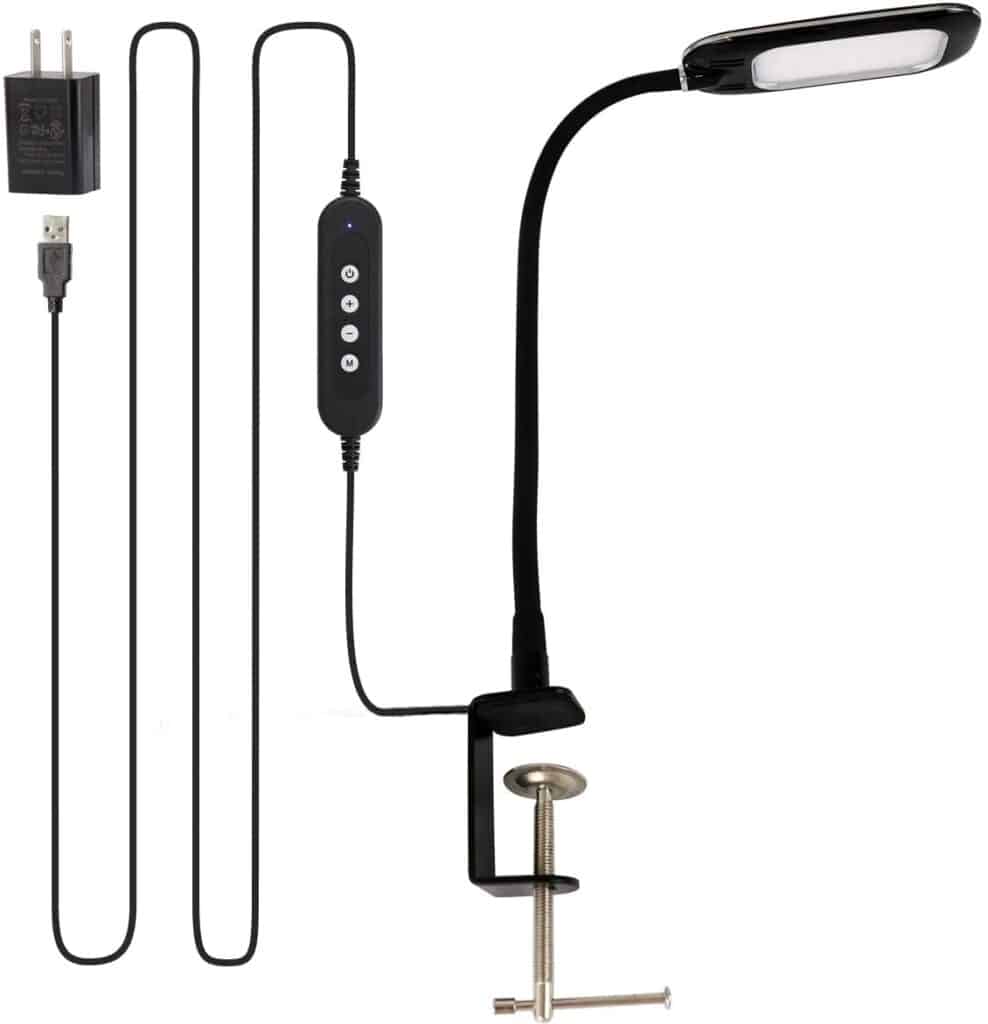
Check the latest price on Amazon: Dott Arts Clmp Desk Lamp
Pros
- The 360-degree gooseneck body is durable and flexible
- The USB cord is available to not worry about the distance between the power socket and the table lamp.
- Night reading light and rapid heat dissipation ensure that the wick has been continuously stable and efficient.
- Additionally, the eco-friendly LED light consumes 80% less power than traditional incandescent lights.
- High-quality LED chips offer non-ghosting and non-flickering light.
Cons
- Sometimes it appears too bright, making it hard to read anything
- Some users have reported loose base connections.
3. HaFundy LED Home Office Desk Lamp
The home office desk lights by HaFundy are some of the most versatile light that provides the user with the best value of their money.
Despite being lightweight, which assists in its portability, they are as sturdy as it gets and offers top-quality brightness and maneuverability.
Furthermore, this product helps you in your office’s needs and assists you in making the most of your daily activities.
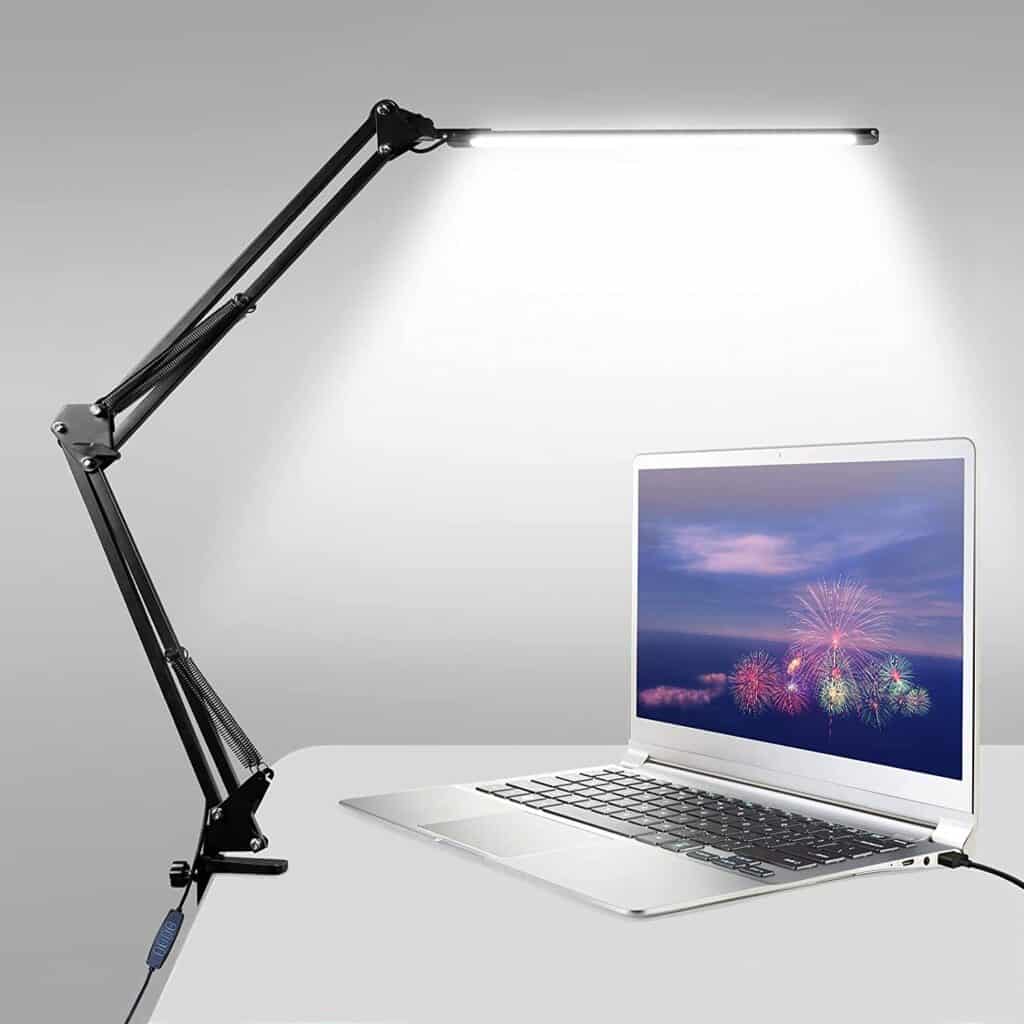
Check the latest price on Amazon: HaFundy LED Home Office Desk Lam
Pros
- Provides three kinds of lights, including white light, daylight, and warm light, which can be adjusted as per the requirement in 10 different levels.
- An adjustable metal arm allows for 360 degrees rotating light, 270-degree rotating base, and 180-degree adjustable arm.
- This light has been designed with no ghosting, no strobe, and no shadow that keeps you focused and productive when you’re working.
Cons
- It can get hot over prolonged usage.
- It doesn’t have high durability compared to others.
Add Cool Desk Accessories to imrove its look and efficiency.
4. LED Desk Lamp with Pen Holder
This desk lamp is long-lasting, and eye-protecting includes 50,000 hours of long-lasting led beads and an eye-protecting function.
There is no light for shadows, dizziness, or unwanted flash. It’s perfect for writing, drawing, and crafting. It includes 3 brightness and 3 color modes as a dimmable desk lamp, for a total of 9 brightness levels (max 350lm).
The little charming desk lamps have a gooseneck chrome that allows you to point your light in any direction.
You can effortlessly move it around in the home, business, or college, as well as while working or traveling, thanks to its lightweight design and built-in battery.
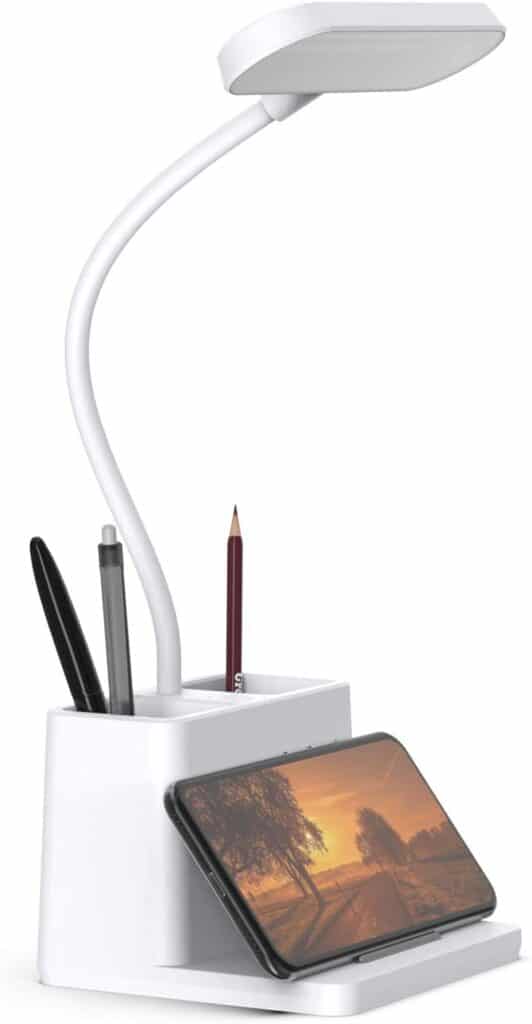
Check the latest price on Amazon: LED Desk Lamp With Pen Holder
Pros
- Adjustable and Lightweight
- Touch control settings
- Eye protecting and dimmable
- Perfect for kid’s study table.
Cons
- Some users have reported the power cord to be too short.
5. BenQ e-Reading Led Desk Lamp –Best For Anti-Glare
The Desktop Dial’s built-in ambient light sensor allows you to choose the ideal brightness level with only one touch; the auto-dimming function will take care of the rest!
You can also change the brightness and color temperature manually at any time. It’s simple to use and precise.
When in use, the different lighting levels provide a flicker-free or glare-free user experience, making it highly smooth and comfortable on the eyes, lowering the danger of eye strain.
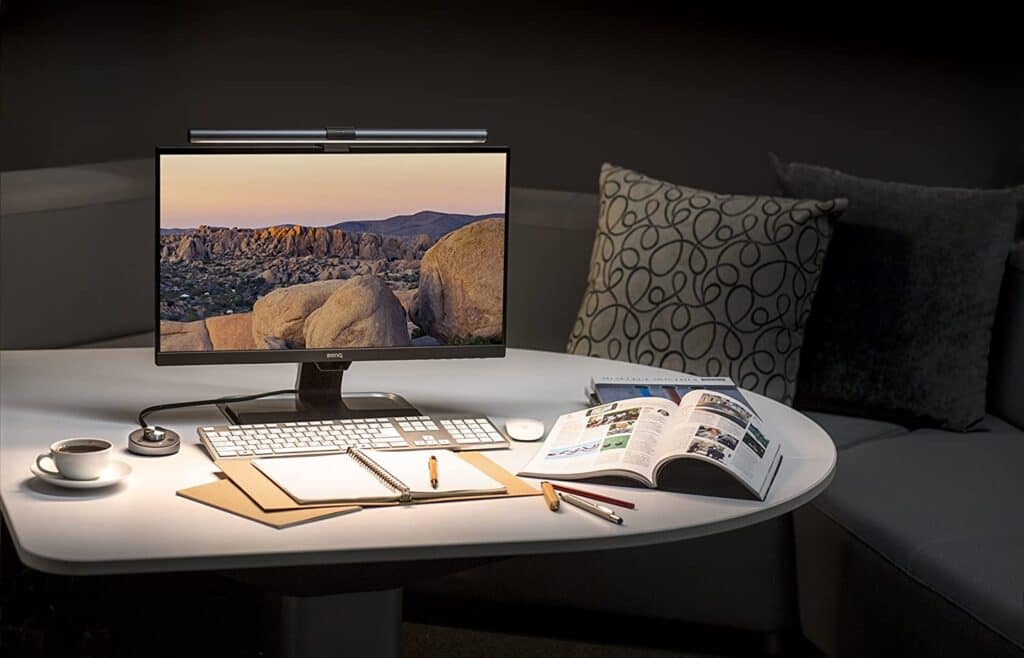
Check the Latest Price on Amazon: BenQ e-Reading Led Desk Lamp
Pros
- Beautiful and practical design.
- Fully adjustable and versatile
- It comes with an automated dimmer that adjusts to the environment in the room.
Cons
- This light is a little expensive.
Conclusion
When selecting a suitable desk lamp for your workstation and specific requirements, you must consider several factors. Therefore, before you buy anything, you should conduct your research.
After reading through this article, we hope you can choose the best desk light for your home office and be more productive in your work.
Read more: An Ultimate Guide to Best Lighting Setup for Zoom


